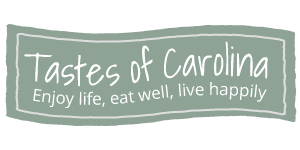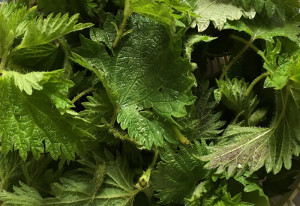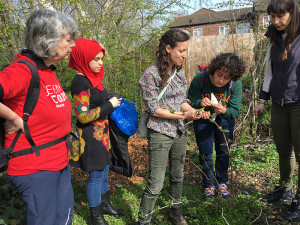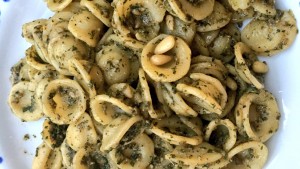This has been a week of wild pickings. The last of the springtime sunshine (I am now sitting under a rather grey sky, back in wintertime it seems) gave me the opportunity to go out for long walks with my dog, at the same time learning about a huge variety of different herbs and plants, then taking my first steps in the kitchen to experiment with them.
Leading the walk on Saturday was the brilliant Jo Homan from Edible Landscapes London. In less then two hours spent between Daubney Fields and Hackney Marshes we encountered so many plants I can only remember a few. The soft and creamy mallow, ingredient of many North African and Mediterranean dishes and the versatile three cornered leek, whose bulbs can be pickled and whose flowers and leaves can be used in pestos and as a garnish, much in the same way of wild garlic, were just some of our discoveries.
I was surprised to learn young bramble buds taste fresh and aromatic, like a distant reminder of the blackberries to come. I never knew you can pickle both dandelion buds and green elderberries (they end up looking and tasting like capers, slightly more aromatic) and that there is a widely growing weed, nicknamed sticky willy, that apart from sticking on your clothes also tastes delicious.
We also learnt how to tell apart the deadly hemlock from its rather innocuous relatives, cow parsley and sweet cicely, although after hearing again how it kills, I’d rather leave all the plants resembling it alone.
And hemlock is not the only thing you need to be mindful of if you want to enjoy a day of wild pickings. You should also make sure you pick your herbs in a place which is as far away as possible from traffic and managed grounds. Another thing I learnt this week is that most councils spray public areas with dangerous weed killers and insecticides. Many times they use Roundup, whose main ingredient is glyphosate, a toxic chemical proven to cause cancer. My neighbourhood just started a petition for a Pesticide Free Hackney, to follow the footsteps of cities like Paris, Toronto and the nearest Brighton, which have banned their use. This is important for everyone, especially if you have children, who are particularly sensitive to these kind of chemicals.
Inspired by the walk, the next day I went back to the Marshes and, armed with latex gloves, I picked more nettle. Nettle is part of the herbs classed as mineral accumulators: its roots pick up a lot of nutrients from the soil and both as a tea and used raw in recipes such as this one is extremely nourishing. It is a diuretic and a tonic, and its sting is actually good for you if you suffer from arthritis. The result of my latest wild pickings has been this pesto, whose pasta recipe I am sharing with you. I hope you enjoy it as much as my DishNextDoor diners did.
Ingredients:
Makes pesto for 7
a 100g bag of nettles, washed and trimmed of the thicker stalks
a small handful of wild garlic leaves
10 three cornered leek buds
one small garlic clove (optional)
20g sunflower seeds
20g pine nuts
10g walnuts
extra virgin olive oil as needed
a pinch of salt
Wash your herbs very thoroughly in water and bicarbonate of soda. This helps drawing dirt and impurities out of the leaves. Ideally you should do this for all fruit and vegetables you buy that are not organic.
Put your herbs and nuts in a food processor, add oil and salt and blitz till all the mixture is uniform. Check for strength of taste. I added a small garlic clove but quickly regretted it. This could have easily been made with just the foraged herbs.
You can use this pesto for virtually anything. In sandwiches and wraps, to stuff chicken breast, or more obviously, to garnish pasta. I did orecchiette with pesto and added a tablespoon of fresh breadcrumbs and a sprinkle of dried chilli to each portion. But I leave it to you. Try and let me know.
Health score: 9



